 I am from the Goose and I saw two geese. Maybe three.
I am from the Goose and I saw two geese. Maybe three.
I love this zuizhi because when I first took it in my hands, I immediately saw two geese, and I happen to proudly belong to the Noble Contrada of the Goose (“Oca”)
in Siena.
I love this zuizhi because after days and days of research to find out what it represents, I finally found the solution on page 75 of Pat Welch’s book: “A goose or geese in a picture with a man dressed as a scholar wearing a loose robe and cap and usually with a table and calligraphy brushes close by, will be a reference to the famous fourth-century calligrapher Wang Xizhi (ca. 303-361).”
Wang Xizhi is particularly remembered for one of his hobbies: rearing geese. Legend has it that he learnt the key of how to turn his wrist while writing by observing how the geese move their necks. It is said that in Shanyin County a Taoist monk had long wished to have a hand-written copy of the Daodejing in the calligraphy of Wang Xizhi. The monk had not made acquaintance with Wang Xizhi and he could not afford to pay for the work. But he came to know that Wang Xizhi had a passion for geese. So he raised a flock of beautiful geese next to his Taoist temple. One day WangXizhi saw the geese and he really took a fancy to them, and wished to buy them and take them back home. The Taoist said to him, ”I would like to present you with these geese on condition that you write a copy of the Daodejing by Laozi for me.” Delighted with this, Wang Xizhi spent the whole day writing in his calligraphy the scripture for the monk. Later he took the geese home with great pleasure. So everybody was happy: Wang Xizhi, the Monk and, possibly, the geese.
Now look at the zhuizhi:
there is famous fourth-century calligrapher, Wang Xizhi. He is under a pine tree, which is almost always represented as in the famous Qian Xuan painting of 1290.
In front of him is the Taoist monk who is trading his flock of beautiful geese.
And there are the geese which Wang Xizhi (and I) love so much.
And flying down from a branch of the tree, here is another goose or, may be a magpie. Why a magpie? Pat Welch suggests: “Sometimes magpies are included to seal the imagery into the commonly understood wish: “May you and your spouse live happily ever after.”
I love this zuizhi because every day it talks to me of poetry, passion, and humor.
A lyric idea: the pine-tree bends to give shadow and shelter to the writing Wang Xizhi. It so sweet to give the gift of such sensitivity to a vegetal being.
A story of a long lived love: the geese are considered an appropriate subject for a couple who have passed many years together and are now in the winter of their lives. Just like Giovanna and myself.
A nice touch of humor: the carver could have placed the lower goose anywhere, but he decided to make it look as if the goose is pecking the monk’s ass. Why? Maybe because, like a bride leaving her parents’ home, the goose feels some kind of happy melancholy and lovingly punishes the monk who had raised her with a gentle peck in the ass. Pure genius.

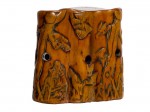
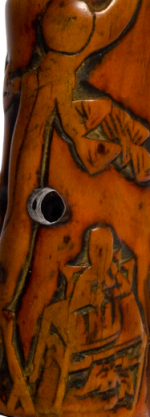
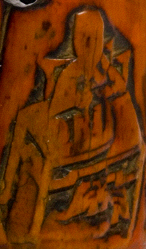

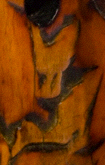
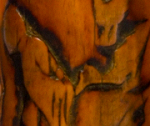
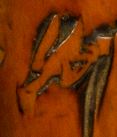
Thank you Franco, for the kind words about my book, Chinese Art: A Guide to Motifs and Visual Imagery.
Magpies are wonderful symbols, found frequently in Chinese art. They were once even known in Chinese as “good luck” birds (xique) as their presence is always supposed to signal good luck is going to come your way. How do you identify them? When painted, they are black and white (or sometimes green and yellow, depending on whether the colors can be reproduced in the particular media being used or not) and when drawn, they have nice long tails that are darker than their bodies. Moreover, when magpies are high up in trees (as in your piece), they have the extra meaning of wishing you happiness up to your eyebrows (it’s a homophone in Chinese, xishang meishao) So your magpie in the branch is wishing the wearer of this little charm a LOT of good luck, as I wish you in your studies and collecting.
Interesting, Franco. I must admit I’ve never seen
the story of Wang Xizhi and his geese depicted on a toggle before.
So you have a real treasure.
Margaret Duda